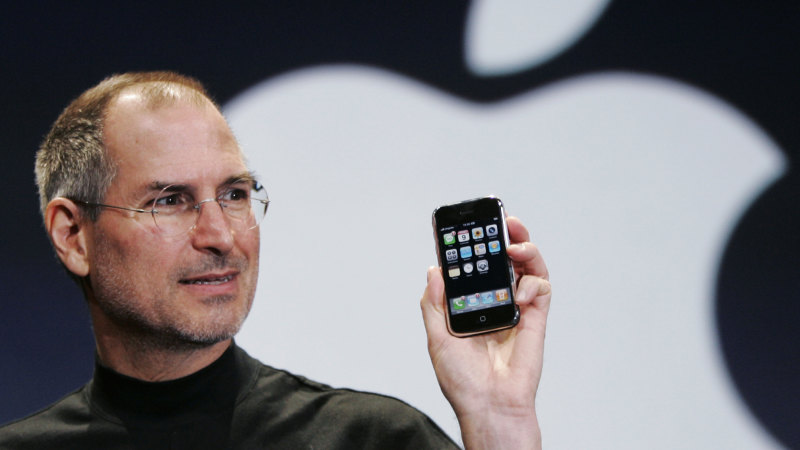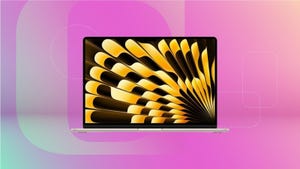
“This is a day I’ve been looking forward to for two and a half years,” Apple CEO Steve Jobs, donning his trademark Levi’s and turtleneck, told an awed crowd on a January morning in San Francisco in 2007. “Every once in a while, a revolutionary product comes along that changes everything. One is very fortunate if you get to work on just one of these in your career.
” Tech CEOs are the new rock stars, and Jobs was well ahead of his time. He had the audience in the palm of his hand, as he often did. And he implicitly believed that the product he was announcing would change the world.

“An iPod, a phone and an internet communicator. An iPod, a phone..
. Are you getting it?” he asked the audience. “These are not separate devices.
This is one device. And we are calling it iPhone. Today Apple is going to reinvent the phone.
” Steve Jobs with the first Apple iPhone. Credit: AP Nearly two decades and more than two dozen iPhone models later, Jobs has been vindicated. The iPhone has left an indelible mark on society, particularly in Australia, where it has long been the nation’s dominant smartphone.
The iPhone was, perhaps, the world’s first ‘smartphone’. It banished the Blackberry, and really, all phones with keyboards, to the past, ushering in a new era of portable productivity. Mobile phones, and our relationship to them, have never been the same.
Reviewing the iPhone 3GS was one of my first journalism efforts, some 15 years ago in June 2009 when I’d just started working for small technology news outlet iTWire . The iPhone 3GS was the second iPhone model available in Australia, following the iPhone 3G, which had landed in 2008. The iPhone 3GS, released in 2009.
I noted at the time the new phone added important features including MMS (multimedia) messaging, copy and paste, and a landscape keyboard, features that have since given way to things like artificial intelligence, 48-megapixel ultrawide lenses and wireless charging that adorn today’s iPhones. The 2009 iPhone release also spawned the phenomenon of Apple fanboys who slept overnight outside the Apple Store to be first in line for the new phone. Another feature associated with the iPhone that’s no longer relevant in 2024.
“In terms of the different smartphones available, taste is a very individual thing, so duck into your local retailer and see what suits your style,” I wrote in 2009. “Right now though, looking at the options, the iPhone 3GS is decidedly the phone to beat. At least until next year’s model.
” My opinion on iPhone hasn’t really changed in 15 years. Different phones suit different people, but for most people who ask me ‘what phone should I get’, the iPhone is an easy, though of course not definitive, answer. And most Australian smartphone purchasers agree.
Australia is one of Apple’s most dominant markets. More than half of smartphones sold here every year are iPhones. Apple’s phones command a 53 per cent market share in Australia, according to the latest figures from research firm IDC.
Samsung is in second place with 28 per cent market share. Chinese-owned Oppo is a distant third, with just 5 per cent market share. There are a few reasons why Australians love the iPhone.
We are relatively wealthy, globally speaking, and we have a higher level of disposable income than most other markets. An iPhone still remains something of a status symbol and disdain is common (if unfair), if your friend can’t message you back using Apple’s iMessage. Foad Fadaghi, managing director of analyst firm Telsyte, says iPhone customer retention is considered the benchmark for customer loyalty across any sector.
“Since 2020, iPhone’s repeat purchase rate in Australia was 85 per cent or higher according to Telsyte’s half-yearly measurement, higher than any other vendor. And it’s always been above 80 per cent since we began measuring in 2016,” he says. Over the past 15 years, I’ve flitted between phones and manufacturers, as my role as technology editor demands.
You pick up nuances across different devices. Samsung’s smartphones tend to have better battery life than iPhones, better cameras and superior display technology. Android phones are a bit fiddlier, but they allow for much more customisation, and you’re not locked into Apple’s App store for installing apps.
Some of them boast fun, zany features: Samsung’s foldable phones are a delight, and the Fairphone is a bold experiment in modular hardware, in which you can use a screwdriver to replace all of its parts. Yet for me, fairly or unfairly, iPhone always felt like home. And that’s exactly how Apple wants it.
Apple has designed its ‘walled garden’ ecosystem very specifically so that if you use an iPhone, it’ll be quick and easy for you to pick up an Apple Watch, iPad or MacBook and have a similar app experience, as all your personal data and settings follow you across devices. The iPhone 15 was released in 2023. Credit: Tim Biggs Everything just works as it should.
But that does come at a cost. Once you’re locked in to the Apple ecosystem, it’s increasingly difficult to opt out. Over 15 years, the amount of time and money I’ve spent on my iPhone apps, as well as my iMessage history and iCloud data like photos and notes, mean any shift back to Android feels monumental, even if that’s more perception than reality.
Another more literal cost is financial. The iPhone generally speaking has always been at least as expensive as its high-end rivals from Samsung and Google, and more expensive than most other Android phones available. App developers have paid a price, too.
Apple has long come under criticism from app developers and Australia’s competition watchdog over the fees it charges to be in the App Store, 30 per cent for large developers and 15 for smaller ones. It’s an ongoing issue: Apple is, in fact, embroiled in a Federal Court trial with Fortnite maker Epic Games over that very issue. The App Store started as a humble place to download Angry Birds or to drink a virtual beer with the iBeer app, but it has grown into one of Apple’s biggest money spinners and it is at the centre of our new digital economy.
App makers can make a lot of money from being in the App Store, but many think Apple takes too large a cut from every transaction. iPhones have maintained their popularity with Australians since release, and they’re about to get a real shot in the arm, not because of any new flashy hardware, but instead because of new artificial intelligence features that are about to be fully baked into the devices. We’re at a precipice that feels not dissimilar to when iPhones usurped BlackBerry and Nokia devices: Generative AI will be a game-changer and Apple knows this, which would explain why it was quick to announce ‘Apple Intelligence’ for its next wave of phones.
Fadaghi says while the next iPhone is likely to be an incremental upgrade in terms of hardware, the new AI features will help future-proof the purchase for Apple’s customer base and their 20-year love affair with the device that reinvented the phone. The next iPhone iteration, iPhone 16, will be launched at the Steve Jobs Theatre in California on September 9. Get news and reviews on technology, gadgets and gaming in our Technology newsletter every Friday.
Sign up here..













